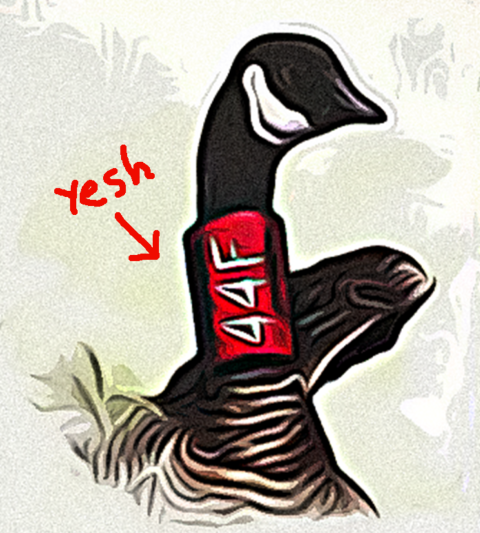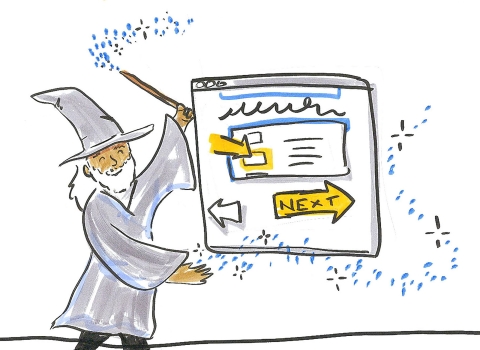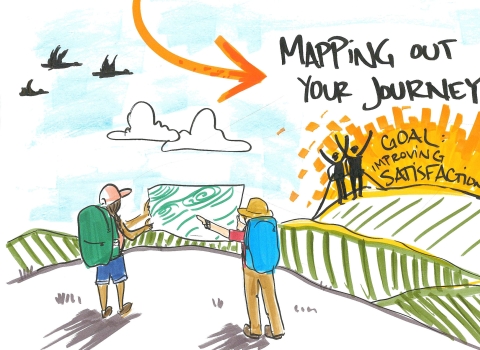EDITOR'S NOTE: 2023 marks the golden anniversary of the ESA, a law that has been a powerful catalyst for conservation of America’s most treasured fish, wildlife, plants and their habitats for five decades. People power the mission of the U.S. Fish and Wildlife Service. Here in the Pacific Region, Tribal, federal and state partners, local supporters, and our dedicated staff are the driving force behind the successes we share and the strength ensuring we can continue to face the challenges ahead. Throughout this year-long celebration, we invite you to celebrate this milestone with us as we reflect on past successes, assess current challenges, and envision an equally bright future for the next 50 years and beyond.
View a storymap of this story with additional audio and video content. You can also view audio transcripts.
Wildlife biologist Joe Sands knew the geese were out there. He just knew it. But I—with little experience in surveying for waterfowl (or surveying anything, really)—had some doubts.
By 2 p.m., Joe, migratory birds wildlife biologists Roberta Swift and Lily Calderón, and I had driven all over most of the northern end of Oregon’s Willamette Valley looking for dusky Canada geese. The four of us had driven through tiny back roads and main thoroughfares, as far south as Baskett Slough National Wildlife Refuge and back up through Gaston, about an hour outside of Portland. Joe was at the wheel, relying on just his surprisingly reliable sense of direction and experience with the fields and wetlands in the area to not get lost. We had seen all kinds of birds: pintails, coots, blue herons, kestrels, hawks, and eagles, to name a few. As for duskys, we’d found zilch.
The Pacific Flyway Council , a group composed of representatives from wildlife management agencies in the United States, Mexico, and Canada, has named the dusky Canada goose a Species of Concern . Duskys do not receive any formal protection under the Endangered Species Act , but there is international coordination to monitor and safeguard dusky populations. The actions taken by the Service and international partners provide critical information for decision-making that keeps species from being listed.
Every year, wildlife biologists from state and federal agencies in the Pacific Northwest take part in surveying dusky Canada geese. During the summer, teams in Alaska tag approximately 600 geese with red collars that each have a three-figure alphanumeric code. During the winter, surveyors in Oregon and Washington get equipped with scopes, binoculars, GPS systems, and survey forms, and crisscross roads through dusky habitat and search for the tell-tale collars. The goal is to find enough geese to develop population estimates on how many geese are migrating down the Pacific Flyway, and ultimately, total population numbers.
The Realities of Surveying: Animals Do What Animals Want to Do
I am, for all practical purposes, a beginning birder.
I own a pair of binoculars, but still sometimes forget to take the lens caps off. I’ve learned to tell the difference between a scrub jay and a Steller’s jay--it's all about the mohawk!--but can't differentiate among species of waterfowl even if they came with pop-up labels. In comparison, Joe, Roberta, and Lily can identify birds while driving down the road at full speed and with what seem to be just a flick of their eyeballs.
When we first piled into Joe’s truck the morning of the survey, hope for geese-finding abounded. The shockingly skilled Lily, Roberta, and Joe were born ready. My binoculars rested on my lap, lens caps already off. The road stretched before us, our very own migratory route to survey glory.
And then we started driving—and the reality of life as a bird surveyor settled in.
We wound our way from Newberg, Oregon, south past McMinnville towards Baskett Slough National Wildlife Refuge. Once we were off the main roads, Joe slowed down past fields where he had previously seen duskys. We’d head for a particular piece of land or large puddle, and Joe would throw down a near-guarantee that we were going to find birds.
However, the blue and beauty of surveying for wildlife is that animals are going to do what animals are going to do. They don’t care about our human efforts to count them; they fly and run and crawl and swim in all their dazzling freedom, and we’re just there to observe. Part of our job at the Service is to help make sure these animals stick around for future generations. Unfortunately for me and my binoculars, sometimes that makes for slow survey days.
We saw a lot of birds on the way to the refuge but nary a dusky. I captured an audio clip of my wildlife biologist guides discussing birds—or lack thereof—and my biologist colleagues’ unending optimism.
Baskett Slough National Wildlife Refuge: A Beautiful Goose Egg
At about 11 a.m. we arrived. Located near Amity, Oregon, Baskett Slough National Wildlife Refuge was established in 1965 to provide wintering habitat for dusky Canada geese. It’s one of the premiere destinations for birdwatching in the northern Willamette Valley. Visitors can see a wide variety of birds, including many species of raptor, songbirds that like oak and prairie habitat, shorebirds, and of course, waterfowl.
Most of the refuge was purchased with the help of Federal Duck Stamps , conservation revenue stamps used to acquire wetland habitat for the National Wildlife Refuge System. Wetlands acquired with duck stamp dollars help purify water, aid in flood control, reduce soil erosion, and enhance outdoor recreation opportunities, in addition to providing a home for a variety of birds and other wildlife.
Decoys!
After our dusky-less stop at Baskett Slough National Wildlife Refuge, we continued to drive down backroads in the northern Willamette Valley. We passed through typical dusky habitat: wetlands, open fields, and even agricultural land with perennial grasses.
As we slowly drove up one road, we rounded a corner and approached what looked like a flock of geese in someone’s front yard.
“Are those…geese?” Roberta asked.
Even though the geese were only about 10 feet away, I pulled out my binoculars. This was my moment.
“I think those are just decoys,” Lily said.
I saw that the birds weren’t moving. They were also pegged to the ground with sticks.
“Definitely decoys,” I confirmed. I felt proud about my first waterfowl identification of the day. And a bit confused.
“Why would someone put fake geese in their front yard?” I asked.
Roberta shrugged. “Maybe they just like geese.”
“Like yard art,” Lily added.
“It could be for hunting, too,” Joe said. “People use flocks of decoys to encourage other birds to land. Birds feel safer when they see other birds, and decoys are a common tool that hunters use.”
“But in their front yard?” I asked.
Joe shrugged. “To each their own.”
I considered Joe’s words. The thought struck me: I have so much to learn.
Seeing Red: Sometimes Things DO Work Out
Late into the afternoon, we made our way north through back roads and quiet neighborhoods until we drove past Wapato Lake National Wildlife Refuge near Gaston. We occasionally pulled over to the side of the road, Joe protesting that there had been birds here at some point in history, that they were out here somewhere, and that we all just needed a little faith. Roberta and Lily were equally sanguine, but also gently starting to ahem-ahem that maybe sometimes things don’t work out.
I had mostly given up on the idea of finding our elusive dusky geese. More importantly, I had a blog to write, and I already knew that it was going to be about what happens when you spend a day in a car with three wildlife biologists and all you get is bupkis.
Suddenly, Roberta yelled. Lily pointed. Joe pulled over to the side of a road next to a large, human-made pool of what looked like agricultural runoff. There was a small flock of about 20 geese sitting in the water. I was perplexed that this patch of water could be goose habitat, but Joe later clarified that geese aren’t particularly picky about habitat on their migration routes and will settle wherever they can forage (hence goose poop on lawns).
“There’s at least one dusky there!” Roberta said as she set up her scope.
“More than one,” Joe added, “but I only see one red collar. Can you read the numbers?”
Joe, Roberta, and Lily waited patiently for the one collared goose to float far enough away from his goose buddies to get an unobstructed view of the collar. Writing down the collar number was imperative: It was the way to track how far, and how long it took for this goose to travel from Alaska to Oregon. It was an undeniably exciting moment; the international team of biologists working to track geese would use this data point to help make conservation decisions. A frisson of exhilaration ran through our team.It was only one collar, but every counted collar was important.
After our first sighting, we found two more collared duskys at another stop. Joe and Roberta revealed that they had been able to find as many as 20 collared dusky geese in one day. The more you go surveying, Joe said, the more likely you’ll have really successful days. Really successful days means more information for conservation. As for more conservation—that’s our jobs.
The day turned out to be a wild goose chase that ended up in dozens of birds, three collared geese, two National Wildlife Refuges, and hours of camaraderie. In the day in the life of a surveyor, that’s not so bad at all.









